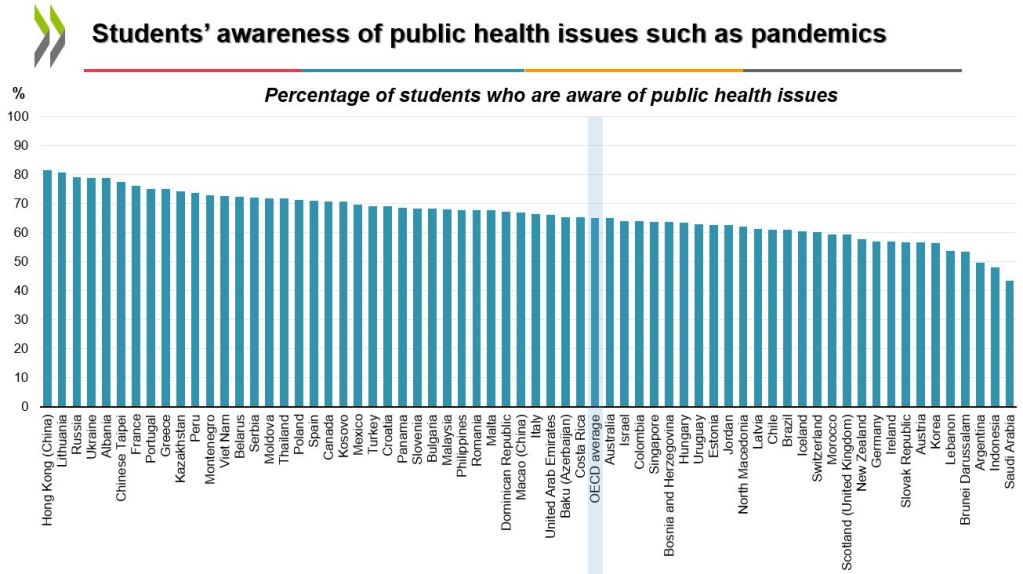By Andreas Schleicher
Director, OECD Directorate for Education and Skills
If you asked 15-year-olds right now about a pandemic, most would probably respond they know something about it and could explain it at least in general terms. In 2018, before the coronavirus (COVID-19) pandemic hit, that was different. In 2018, the Programme for International Student Assessment (PISA) asked students whether they were aware of global health issues such as pandemics. They could answer on a four-point scale: “I have never heard of this”, “I have heard about this but I would not be able to explain what it is really about”, “I know something about this and could explain the general issue”, and “I am familiar with this and I would be able to explain this well”. In Hong Kong (China) and Lithuania, over 80% of students responded that they know something about it and could at least explain the general issue. However, in Saudi Arabia it was just 43% and in Argentina and Indonesia still less than half. Importantly, knowledge in science doesn’t automatically imply awareness: Even in some countries that do well on the PISA science assessment, such as Korea, Switzerland, Germany or New Zealand, the percentage of students aware of global health issues was 60% or less.

When there is no pandemic out there, student awareness on global health issues will depend a lot on what happens in schools. So PISA also asked school leaders whether public health issues are covered in the curriculum. In Hong Kong (China), Lithuania and the Russian Federation, high levels of student awareness line up with a high coverage of such issues in the school curriculum. But in countries such as Brunei Darussalam, Korea, Morocco or Latvia, over 90% of school leaders report that global health issues are covered in the curriculum but student awareness was still comparatively low. This suggests that things can get lost in translation, when the intended curriculum becomes the curriculum that is actually implemented in the classroom and ultimately the achieved curriculum mirrored in student awareness and learning outcomes.

Of course, in 2018, no one could anticipate that a pandemic would strike two years later. But the future will always surprise us and it seems that schools can and need to do better to prepare students for a fast-changing, uncertain and volatile world. And public health is not the only pressing issue on the global stage. Climate change may present the biggest challenge for humanity over the years to come. Over the last two decades, the world has also faced growing extremism and radicalisation with concerted worldwide efforts being mobilised to counter this threat. More recently, in May 2020 and the months that followed, the world was swept with protests challenging racial discrimination and the misuse of power. Two years earlier, the #MeToo movement put sexual harassment and abuse in the spotlight. One movement focused on racial equality, the other on gender equality, but both had justice, empowerment and breaking the silence at their heart, and both relied on the willingness of people to show solidarity and to take action for collective well-being.
So beyond issues around public health, PISA also surveyed students on their awareness about other global issues, including climate change and global warning; global health; migration; international conflicts; hunger or malnutrition in different parts of the world; causes of poverty; and equality between men and women. Student answers were then summarised in an index of global awareness. The findings show wide variations between countries in terms of their students’ awareness of global issues.

When looking at individual questionnaire items, on average across OECD countries, students reported that they are most familiar with issues related to gender equality: 83% of students reported that they know about the topic or are very familiar with it. Students are also familiar with migration, climate change, causes of poverty and hunger and malnutrition in different parts of the world: about 78% reported being familiar with those topics. The two topics with which students were the least familiar were global health issues, such as pandemics, and international conflicts.
How countries can prepare students for our increasingly complex world
The question is, of course, what all this means for public policy. It is easy to say that there should have been greater attention to public health issues in the past so that populations could now respond with the level of awareness, knowledge as well as personal and social responsibility that it takes to cope with a pandemic. The trouble is that school curricula are already overcrowded. Over the years, many countries have responded to new demands on what students should learn by layering more and more content on top of their curriculum, with the result that curricula and thus student learning have often become a mile wide but just an inch deep. Teachers are ploughing through a large amount of subject-matter content but with little depth. Adding new material provides an easy way to show the public that education systems respond to emerging demands. But the result is the kind of superficial learning outcomes that PISA reveals for many students and many countries.
More promising seem to be the approaches of some countries to teach fewer things at greater depth, and at the same time broadening the learning experience by integrating emerging subjects, topics and themes into traditional curriculum areas. These approaches recognise the importance of that deep understanding. For example, thinking like a scientist is more important than simply knowing specific formulae or procedures; or thinking like an historian – understanding how the narrative of a society has emerged, developed, advanced, and sometimes unravelled when the context changed – goes well beyond remembering dates, names and places.
What seems needed most is a more careful balance between a “negotiated” and a designed curriculum. In other words, there has to be wide consultation and compromise in selecting what should be taught, but the results must also be a well-designed end product. Public confidence and the engagement of the profession is not just a function of the inclusiveness of the process of curriculum development, which involves wide stakeholder engagement and compromise in selecting what should be taught, but also of the resulting quality of the curriculum and instructional system, which hinges on clear and coherent design principles.
It seems important to think more systematically about what we want to achieve from the design of curricula, rather than continuing to add more “stuff” to what is being taught
It seems important to think more systematically about what we want to achieve from the design of curricula, rather than continuing to add more “stuff” to what is being taught. Twenty-first-century curricula will distinguish themselves by rigour (building what is being taught on a high level of cognitive demand); by focus (aiming at conceptual understanding by prioritising depth over breadth of content); and by coherence (sequencing instruction based on a scientific understanding of learning progressions and human development). They will remain true to the disciplines, while aiming at interdisciplinary learning and building students’ capacity to see problems through multiple lenses. They will balance knowledge of disciplinary content with knowledge about the underlying nature and principles of the disciplines. Not least, to help students address unknown future problems, 21st century curricula need to focus on areas with the highest transfer value, in other words, they need to give priority to knowledge, skills and attitudes that can be learned in one context and applied to others – and to bring teachers along with this idea, they need to be explicit about the theory of action for how this transfer value occurs. Not least, they need to frame learning in relevant and realistic contexts, and help teachers use approaches that are thematic, problem-based, project-based and centred around co-creation with their colleagues and their students. Our Education 2030 programme at the OECD provides a framework for countries for how this can be achieved.
The bottom line is that, these days, education is no longer just about teaching people something or preparing them for all eventualities, but about helping them develop a reliable compass and the tools to navigate with confidence through a world that is increasingly complex, increasingly volatile and increasingly uncertain. Success in education is about identity, it’s about agency and it’s about purpose. It’s about building curiosity – opening minds, it’s about compassion – opening hearts, and it’s about courage, mobilising our cognitive, social and emotional resources to take action. And that’s also going to be our best weapon against the biggest threats of our times – ignorance – the closed mind, hate – the closed heart, and fear – the enemy of agency.
Read more:
- Are students ready to thrive in an interconnected world? The first PISA assessment of global competence provides some answers
- Are Students Ready to Thrive in an Interconnected World? PISA 2018 Results Volume VI
- Learn more about PISA
- Advancing schooling beyond coronavirus: New insights from PISA
- Lessons for education during the coronavirus crisis
- The OECD coronavirus (COVID-19) policy hub


